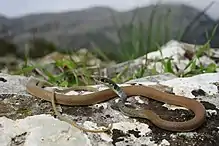Platyceps najadum
Platyceps najadum, known commonly as Dahl's whip snake, the slender whip snake, and the Zagros whip snake, is a species of snake in the family Colubridae.
| Platyceps najadum | |
|---|---|
 | |
| Scientific classification | |
| Kingdom: | Animalia |
| Phylum: | Chordata |
| Class: | Reptilia |
| Order: | Squamata |
| Suborder: | Serpentes |
| Family: | Colubridae |
| Genus: | Platyceps |
| Species: | P. najadum |
| Binomial name | |
| Platyceps najadum (Eichwald, 1831) | |
| Synonyms[2] | |
| |
Taxonomy
Platyceps najadum was first described by Karl Eichwald in 1831,[1] as Tyria najadum.[2]
Geographic range
Platyceps najadum is found in the Balkans, Aegean, Cyprus, the Mid-East, and as far as Turkmenistan and the Caucasus Mountains.[3]
Habitat
P. najadum occurs in dry and xeric environments in a wide range of habitats: in desert and rocky land, in forests, woodland scrub, and agricultural land from sea level to 2,000 m (6,600 ft) altitude. It is commonly found in fields, and seen crushed on roads.
Description
P. najadum has a slim body, and is rarely over a metre (39 inches) in total length (including tail).[4]
Conservation status
P. najadum is threatened by direct persecution, forest fires and intensive agriculture, where its range interacts with human interests.[1]
Subspecies
Four[2] subspecies are identified.
- Platyceps najadum albitemporalis (Darevsky & Orlov, 1994)
- Platyceps najadum dahlii (Fitzinger, 1826) – Balkans, Cyprus, Aegean Turkey
- Platyceps najadum kalymnensis (B. Schneider, 1979) – endemic to Kalymnos island, the Aegean
- Platyceps najadum najadum (Eichwald, 1831) – Caucasus and Asia Minor
Nota bene: A trinomial authority in parentheses indicates that the subspecies was originally described in a genus other than Platyceps.
Etymology
Both the subspecific name, dahlii, and the common name, Dahl's whip snake, are in honor of Swedish botanist Anders Dahl.[5]
The subspecific name, schmidtleri, is in honor of German herpetologist Josef Friedrich Schmidtler (born 1942).[5]
Indigenous names
Σαϊτα (Greek), Saita, Стрелушка (Bulgarian), šilac (Croatian), Za'aman Z'eitani (Hebrew), Ok Yılanı (Turkish).
References
- Lymberakis P, Ajtic R, Tok V, Ugurtas IH, Sevinç M, Crochet P-A, Mousa Disi AM, Hraoui-Bloquet S, Sadek R, Haxhiu I, Böhme W, Agasyan A, Tuniyev B, Ananjeva N, Orlov N (2009). "Platyceps najadum ". IUCN Red List of Threatened Species. 2009: e.T157277A5068046. doi:10.2305/IUCN.UK.2009.RLTS.T157277A5068046.en.
- "Platyceps najadum ". The Reptile Database. http://reptile-database.reptarium.cz/species?genus=Platyceps&species=najadum&search_param=%28%28search%3D%27Platyceps+najadum%27%29%29
- "Platyceps najadum ". French language Wikipédia.
- "Archived copy". Archived from the original on 2014-03-26. Retrieved 2014-03-26.CS1 maint: archived copy as title (link)
- Beolens, Bo; Watkins, Michael; Grayson, Michael (2011). The Eponym Dictionary of Reptiles. Baltimore: Johns Hopkins University Press. xiii + 296 pp. ISBN 978-1-4214-0135-5. (Platyceps najadum dahlii, p. 64; P. n. schmidtleri, p. 236).
Further reading
- Arnold EN, Burton JA (1978). A Field Guide to the Reptiles and Amphibians of Britain and Europe. (Illustrated by D.W. Ovenden). London: Collins. 272 pp. + Plates 1-40. ISBN 0-00-219318-3. (Coluber najadum, pp. 194–195 + Plate 35, figure 4 + Map 106).
- Eichwald [K]E (1831). Zoologia specialis quam expositis animalibus tum vivis, tum fossilibus potissimum Rossiae in universum, et Poloniae in specie, in usum lectionum publicarum, in Universitate Caesarea Vilnensi [Volume 3]. Vilnius: J. Zawadzki. 404 pp. + one plate. (Tyria najadum, new species, p. 174). (in Latin).
